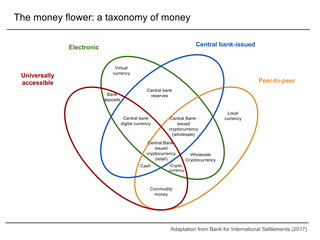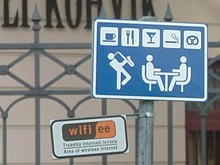
An identity document is a document proving a person's identity.

Digital currency is any currency, money, or money-like asset that is primarily managed, stored or exchanged on digital computer systems, especially over the internet. Types of digital currencies include cryptocurrency, virtual currency and central bank digital currency. Digital currency may be recorded on a distributed database on the internet, a centralized electronic computer database owned by a company or bank, within digital files or even on a stored-value card.

An electronic identification ("eID") is a digital solution for proof of identity of citizens or organizations. They can be used to view to access benefits or services provided by government authorities, banks or other companies, for mobile payments, etc. Apart from online authentication and login, many electronic identity services also give users the option to sign electronic documents with a digital signature.
Permanent residency is a person's legal resident status in a country or territory of which such person is not a citizen but where they have the right to reside on a permanent basis. This is usually for a permanent period; a person with such legal status is known as a permanent resident.
A national identification number, national identity number, or national insurance number or JMBG/EMBG is used by the governments of many countries as a means of tracking their citizens, permanent residents, and temporary residents for the purposes of work, taxation, government benefits, health care, and other governmentally-related functions.
Mobile identity is a development of online authentication and digital signatures, where the SIM card of one's mobile phone works as an identity tool. Mobile identity enables legally binding authentication and transaction signing for online banking, payment confirmation, corporate services, and consuming online content. The user's certificates are maintained on the telecom operator's SIM card and in order to use them, the user has to enter a personal, secret PIN code. When using mobile identity, no separate card reader is needed, as the phone itself already performs both functions.

The Swedish national identity card is a non-compulsory biometric identity document issued in Sweden. It is one of two official identity documents issued by the Swedish Police, the other being the Swedish passport. It is only issued to Swedish citizens, and indicates the citizenship.

The Estonian identity card is a mandatory identity document for citizens of Estonia. In addition to regular identification of a person, an ID-card can also be used for establishing one's identity in electronic environment and for giving one's digital signature. Within Europe as well as French overseas territories, Georgia and Tunisia the Estonian ID-card can be used by the citizens of Estonia as a travel document.
Internet in Estonia has one of the highest penetration rates in the world. In the first quarter of 2010, 75% out of 1.34 million people in the country used the Internet according to Statistics Estonia. In 2017, according to the World Bank came 13th in the world by the percentage of population using the Internet, with 88.1% people using it.
All European countries show eGovernment initiatives, mainly related to the improvement of governance at the national level. Significant eGovernment activities also take place at the European Commission level as well. There is an extensive list of eGovernment Fact Sheets maintained by the European Commission.

The Portuguese identity card, is an identity document issued by the Government of Portugal to its citizens. The card replaces several previous documents, including the Bilhete de Identidade, Social Security card, National Health Service card, Taxpayer card and voter registration card, in one secure card. The Citizen Card was first issued in the Azores in mid-2006. However, as of 2017 BIs continued to be issued in some cases.
Electronic signature allows users to electronically perform the actions for which they previously had to give a signature on paper. Estonia's digital signature system is the foundation for some of its most popular e-services including registering a company online, e-banks, the e-voting system and electronic tax filing – essentially any services that require signatures to prove their validity.
A blockchain is a distributed ledger with growing lists of records (blocks) that are securely linked together via cryptographic hashes. Each block contains a cryptographic hash of the previous block, a timestamp, and transaction data. Since each block contains information about the previous block, they effectively form a chain, with each additional block linking to the ones before it. Consequently, blockchain transactions are irreversible in that, once they are recorded, the data in any given block cannot be altered retroactively without altering all subsequent blocks.

e-Residency of Estonia is a program launched by Estonia on 1 December 2014. The program allows non-Estonians access to Estonian services such as company formation, banking, payment processing, and taxation. The program gives the e-resident a smart card which they can use to sign documents. The program is aimed towards location-independent entrepreneurs such as software developers and writers. The first e-resident of Estonia was British journalist Edward Lucas; the first person to apply for and be granted e-residency through the standard process was Hamid Tahsildoost from the United States.
The once-only principle is an e-government concept that aims to ensure that citizens, institutions, and companies only have to provide certain standard information to the authorities and administrations once. By incorporating data protection regulations and the explicit consent of the users, the public administration is allowed to re-use and exchange the data with each other. The once-only principle is part of the European Union's (EU) plans to further develop the Digital Single Market by reducing the administrative burden on citizens and businesses.
X-Road is a centrally managed distributed Data Exchange Layer (DXL) between information systems. Organizations can exchange information over the Internet using X-Road to ensure confidentiality, integrity and interoperability between data exchange parties.
Veriff is a global identity verification service company founded and headquartered in Tallinn, Estonia. The company offers services for online businesses to mitigate fraud attempts and assisting regulatory compliance. Offering protection from identity fraud and identity theft, Veriff verifies a customer's identity automatically, using an AI that analyzes a multitude of technological and behavioural indicators, including facial recognition. The service is provided to companies as an API, which has been compared to Stripe.
e-Residency of Lithuania is a program launched by Lithuania on 1 January 2021. The program will allow non-Lithuanian citizens to access services provided by the Lithuanian government and other institutions, such as company formation, declaration of taxes and opening of bank accounts. It provides the e-residents with a smart card, similar to the Lithuanian identity card, which can be used for electronic identification and electronic signature.
Smart-ID is an electronic authentication tool developed by SK ID Solutions, an Estonian company. Users can log in to various electronic services and sign documents with an electronic signature.
The Nordic Institute for Interoperability Solutions (NIIS) is a non-profit established in 2017 by Estonia and Finland, with the mission "to develop e-governance solutions...with the X-Road technology used nationwide in the Estonian X-tee and in the Finnish Suomi.fi Data Exchange Layer services". It is funded by both countries, with around 1M€ annually. In 2019, Iceland was invited as well, and later the Faroe Islands.







